The Characterization of Laser-Induced Particles Generated from Aluminum Alloy in High Power Laser Facility
Abstract
1. Introduction
2. Experiment
2.1. Sample Preparation
2.2. Laser Damage Experiments
2.3. Microscopic Morphological Characterization
3. Experimental Results
3.1. Laser Damage Morphology Microstructure
3.2. Particle Contamination from Laser Irradiation
4. Discussion
4.1. Particle Spattering Mechanism under Strong Laser Interaction
4.2. Theoretical Model
5. Conclusions
Author Contributions
Funding
Institutional Review Board Statement
Informed Consent Statement
Data Availability Statement
Conflicts of Interest
References
- Bishop, B. National Ignition Facility Experiment Puts Researchers at Threshold of Fusion Ignition. Lawrence Livermore National Laboratory. 2021. Available online: https://www.llnl.gov/news/national-ignition-facility-experiment-puts-researchers-threshold-fusion-ignition (accessed on 18 August 2021).
- Zylstra, A.B.; Hurricane, O.A.; Callahan, D.A. Burning plasma achieved in inertial fusion. Nature 2022, 601, 542–548. [Google Scholar] [CrossRef] [PubMed]
- Hunt, J.S. National Ignition Facility Performance Review 1999; Lawrence Livermore National Lab: Livermore, CA, USA, 2000. [Google Scholar]
- Manes, K.R.; Spaeth, M.L.; Adams, J.J.; Bowers, M.W.; Bude, J.D.; Carr, C.W.; Conder, A.D.; Cross, D.A.; Demos, S.G.; Di Nicola, J.M.G.; et al. Damage mechanisms avoided or managed for NIF large optics. Fusion Sci. Technol. 2016, 69, 146–249. [Google Scholar] [CrossRef]
- Howland, D.J.; Arenberg, J.; Thomas, M.D.; Turner, T.; Bellum, J.; Carr, C.W.; Brophy, M.; Krisiloff, A.; Carlie, N.; Dabney, M. Laser damage, a new US standard: What is in it for me? Proc. SPIE 2020, 11261, 145–149. [Google Scholar]
- Bude, J.; Miller, P.; Baxamusa, S.; Shen, N.; Laurence, T.; Steele, W.; Suratwala, T.; Wong, L.; Carr, W.; Cross, D.; et al. High fluence laser damage precursors and their mitigation in fused silica. Opt. Express 2014, 22, 5839–5851. [Google Scholar] [CrossRef] [PubMed]
- Ye, H.; Li, Y.; Xu, Q.; Jiang, C.; Wang, Z. Resistance of scratched fused silica surface to UV laser induced damage. Sci. Rep. 2019, 9, 10741. [Google Scholar] [CrossRef] [PubMed]
- Liu, H.J.; Huang, J.; Wang, F.R.; Zhou, X.; Ye, X.; Zhou, X.; Sun, L.; Jiang, X.; Sui, Z.; Zheng, W. Subsurface defects of fused silica optics and laser induced damage at 351 nm. Opt. Express 2013, 21, 12204–12217. [Google Scholar]
- Bloembergen, N. Role of cracks, pores, and absorbing inclusions on laser induced damage threshold at surfaces of transparent dielectrics. Appl. Opt. 1973, 12, 661–664. [Google Scholar] [CrossRef]
- Miller, P.E.; Bude, J.D.; Suratwala, T.I.; Shen, N.; Laurence, T.A.; Steele, W.A.; Menapace, J.; Feit, M.D.; Wong, L.L. Fracture-induced subbandgap absorption as a precursor to optical damage on fused silica surfaces. Opt. Lett. 2010, 35, 2702–2704. [Google Scholar] [CrossRef]
- Demos, S.G.; Hoffman, B.N.; Carr, C.W.; Cross, D.A.; Negres, R.A.; Bude, J.D. Mechanisms of laser-induced damage in absorbing glasses with nanosecond pulses. Opt. Express 2019, 27, 9975–9986. [Google Scholar] [CrossRef]
- Bude, J.; Carr, C.W.; Miller, P.E.; Parham, T.; Whitman, P.; Monticelli, M.; Raman, R.; Cross, D.; Welday, B.; Ravizza, F.; et al. Particle damage sources for fused silica optics and their mitigation on high energy laser systems. Opt. Express 2017, 25, 11414–11435. [Google Scholar] [CrossRef]
- Li, Y.; Yao, C.; Miao, X.; Wang, H.; Jiang, X. Damage morphologies of Al2O3 and Fe particles attached on the input surface of fused silica after irradiation by a 355 nm laser. Appl. Opt. 2021, 60, 8130–8136. [Google Scholar] [CrossRef] [PubMed]
- Suratwala, T.I.; Miller, P.E.; Bude, J.D.; Steele, W.A.; Shen, N.; Monticelli, M.V.; Feit, M.D.; Laurence, T.A.; Norton, M.A.; Carr, C.W.; et al. HF-based etching processes for improving laser damage resistance of fused silica optical surfaces. J. Am. Ceram. Soc. 2011, 94, 416–428. [Google Scholar] [CrossRef]
- Honig, J.; Norton, M.A.; Hollingsworth, W.G.; Donohue, E.E.; Johnson, M.A. Experimental study of 351-nm and 527-nm laser-initiated surface damage on fused silica surfaces due to typical contaminants. Proc. SPIE 2005, 5647, 129–135. [Google Scholar]
- Feit, M.D.; Rubenchik, A.M.; Faux, D.R.; Riddle, R.A.; Shapiro, A.B.; Eder, D.C.; Penetrante, B.M.; Milam, D.; Genin, F.Y.; Kozlowski, M.R. Modeling of laser damage initiated by surface contamination. Proc. SPIE 1997, 2966, 417–424. [Google Scholar]
- Genin, F.Y.; Feit, M.D.; Kozlowski, M.R.; Rubenchik, A.M.; Salleo, A.; Yoshiyama, J. Rear-surface laser damage on 355-nm silica optics owing to Fresnel diffraction on front-surface contamination particles. Appl. Opt. 2000, 39, 3654–3663. [Google Scholar] [CrossRef]
- Palmier, S.; Garcia, S.; Lamaignère, L.; Loiseau, M.; Donval, T.; Rullier, J.L.; Tovena, I.; Servant, L. Surface particulate contamination of the LIL optical components and their evolution under laser irradiation. Proc. SPIE 2007, 6403, 301–310. [Google Scholar]
- Capoulade, J.; Natoli, J.Y.; Palmier, S.; Rullier, J.L.; Tovena, I. Influence of artificial metallic defects size on the surface cleaning process. Proc. SPIE 2007, 6403, 158–166. [Google Scholar]
- Raman, R.N.; Demos, S.G.; Shen, N.; Feigenbaum, E.; Negres, R.A.; Elhadj, S.; Rubenchik, A.M.; Matthews, M.J. Damage on fused silica optics caused by laser ablation of surface-bound microparticles. Opt. Express 2016, 24, 2634–2647. [Google Scholar] [CrossRef]
- Demos, S.G.; Negres, R.A.; Raman, R.N.; Shen, N.; Rubenchik, A.M.; Matthews, M.J. Mechanisms governing the interaction of metallic particles with nanosecond laser pulses. Opt. Express 2016, 24, 7792–7815. [Google Scholar] [CrossRef]
- Mahdieh, M.H.; Nikbakht, M.; Moghadam, Z.E.; Sobhani, M. Crater geometry characterization of Al targets irradiated by single pulse and pulse trains of Nd: YAG laser in ambient air and water. Appl. Surf. Sci. 2010, 256, 1778–1783. [Google Scholar] [CrossRef]
- Porneala, C.; Willis, D.A. Observation of nanosecond laser-induced phase explosion in aluminum. Appl. Phys. Lett. 2006, 89, 211121. [Google Scholar] [CrossRef]
- Zhang, Y.; Zhang, D.; Wu, J.; He, Z.; Deng, X. A thermal model for nanosecond pulsed laser ablation of aluminum. AIP Adv. 2017, 7, 075010. [Google Scholar] [CrossRef]
- Pryatel, J.A.; Gourdin, W.H.; Frieders, S.C.; Ruble, G.S.; Monticelli, M.V. Cleaning practices and facilities for the National Ignition Facility (NIF). Proc. SPIE 2014, 9237, 390–410. [Google Scholar]
- Sommer, S.; Stowers, I.; Van Doren, D. Clean construction protocol for the national ignition facility beampath and utilities. J. IEST 2003, 46, 85–97. [Google Scholar] [CrossRef][Green Version]
- Zhang, G.; Hua, X.; Huang, Y.; Zhang, Y.; Li, F.; Shen, C.; Cheng, J. Investigation on mechanism of oxide removal and plasma behavior during laser cleaning on aluminum alloy. Appl. Surf. Sci. 2020, 506, 144666. [Google Scholar] [CrossRef]
- Li, G.; Gao, W.; Zhang, L.; Wu, X.; Zhang, L.; Wei, Z.; Li, B.; Xue, Y.; Wang, J.; Wang, X. The quality improvement of laser rubber removal for laminated metal valves. Opt. Laser Technol. 2021, 139, 106785. [Google Scholar] [CrossRef]
- Lamkharbach, Y.; Bazi, F.; Haji, L.; Bennani, L.; Mourran, A.; Bouamrani, M.L. Study of changing statistics model’s influence on the exploitation and conformity of results in the new standard version ISO 14644 part 1. Period. Eng. Nat. Sci. 2019, 6, 436–446. [Google Scholar] [CrossRef]
- Zhu, D.; Chen, Y.; Li, P.; Feng, B.; Pang, Y. Design and management of stray light for compact final optics assembly on the high energy laser system. Int. J. Opt. 2021, 2021, 6655866. [Google Scholar] [CrossRef]
- Liu, X.; Deng, W.J.; Chen, H.T.; Zhang, B. Scale Thorn Formation Regularity and Inhibitory Measures in Cryogenic Cutting Processes of Aluminum Alloy 7075. China Mech. Eng. 2022, 33, 262–269. [Google Scholar]
- Born, M.; Wolf, E. Principles of Optics: Electromagnetic Theory of Propagation, Interference and Diffraction of Light, 7th ed.; Cambridge University Press: Cambridge, UK, 2013; pp. 32–44. [Google Scholar]
- Mittal, K.L. Particles on Surfaces: Detection, Adhesion and Removal; CRC Press: Boca Raton, FL, USA, 2006; pp. 4–32. [Google Scholar]
- Lu, Y.F.; Song, W.D.; Ang, B.W.; Hong, M.; Chan, D.; Low, T. A theoretical model for laser removal of particles from solid surfaces. Appl. Phys. A 1997, 65, 9–13. [Google Scholar] [CrossRef]
- Tam, A.C.; Leung, W.P.; Zapka, W.; Ziemlich, W. Laser-cleaning techniques for removal of surface particulates. J. Appl. Phys. 1992, 72, 3515–3523. [Google Scholar] [CrossRef]
- Kumar, A.; Biswas, D.J. Particulate size and shape effects in laser cleaning of heavy metal oxide loose contamination off clad surface. Opt. Laser Technol. 2018, 106, 286–293. [Google Scholar] [CrossRef]
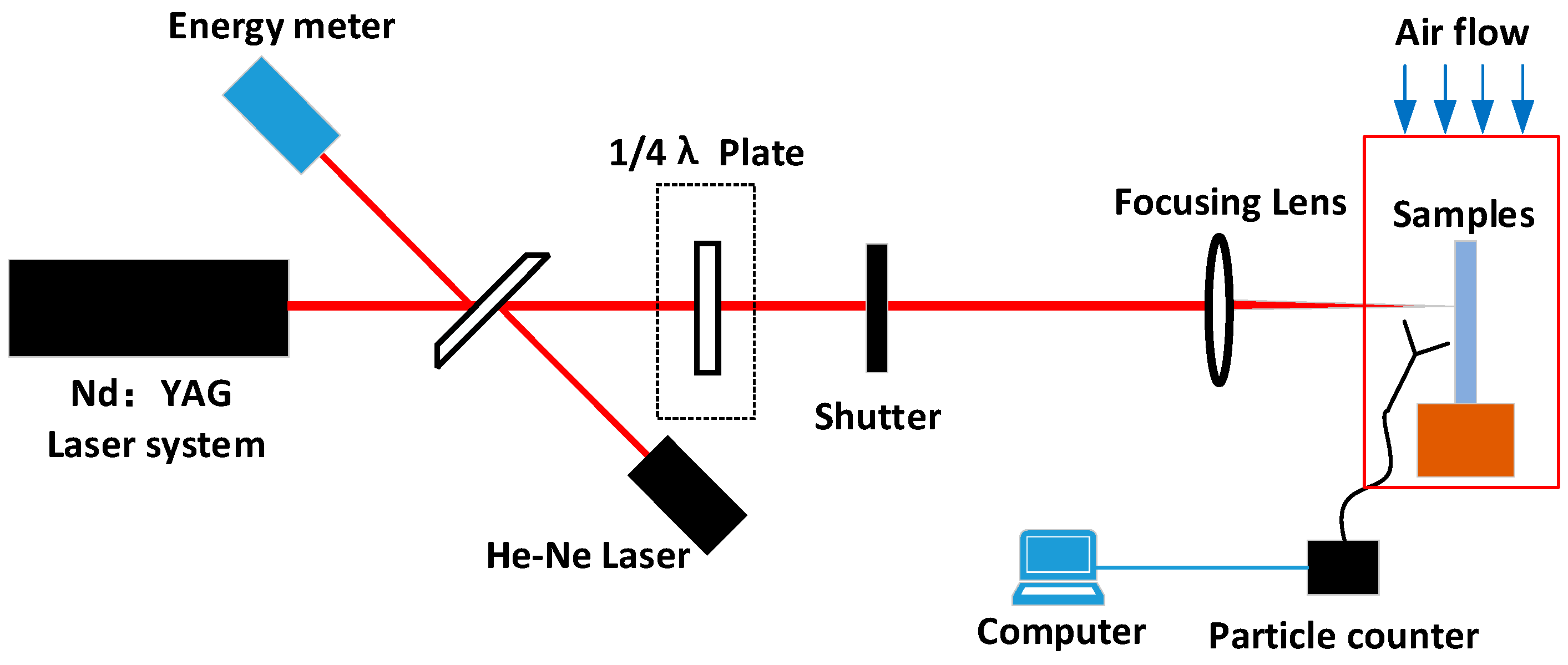

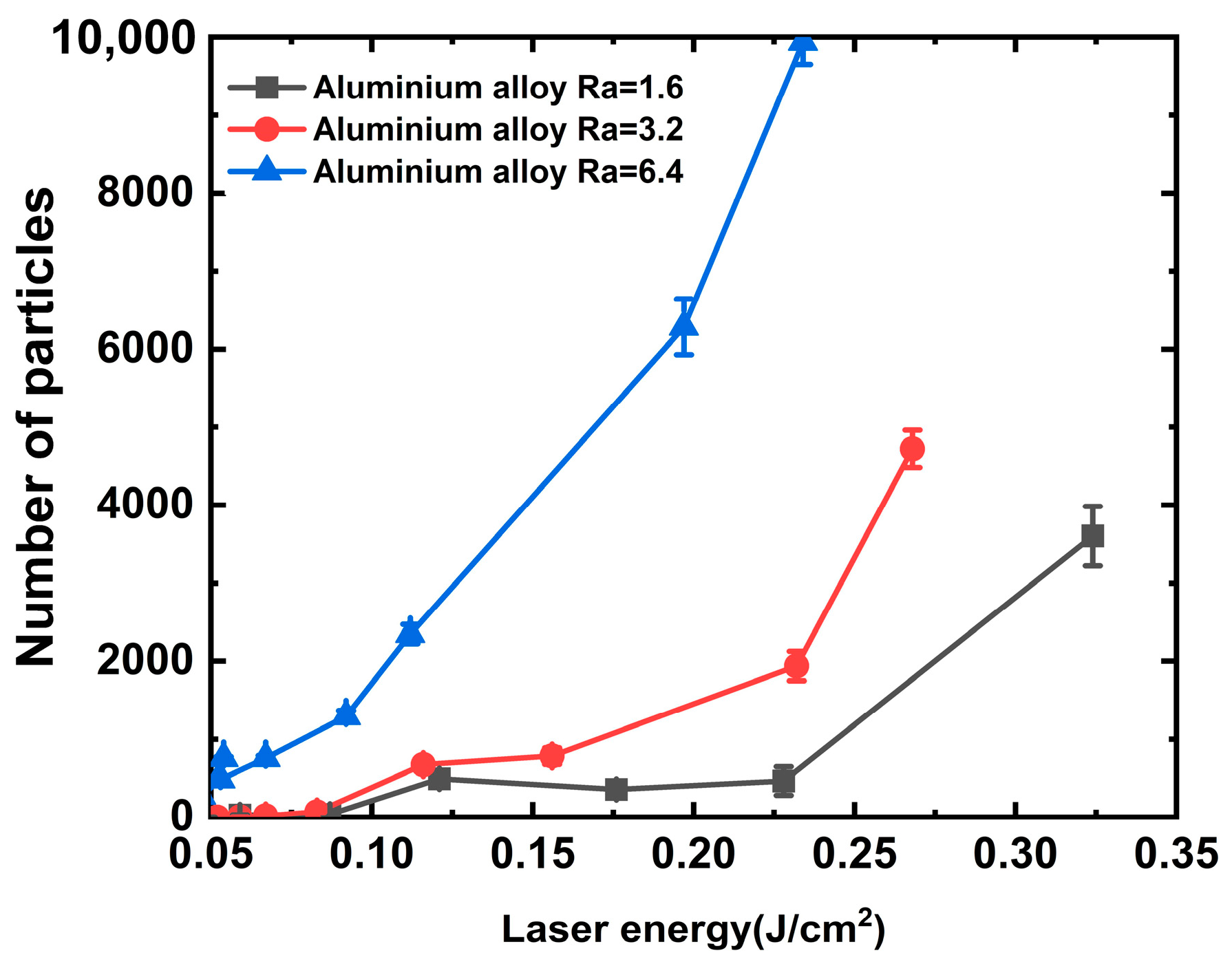
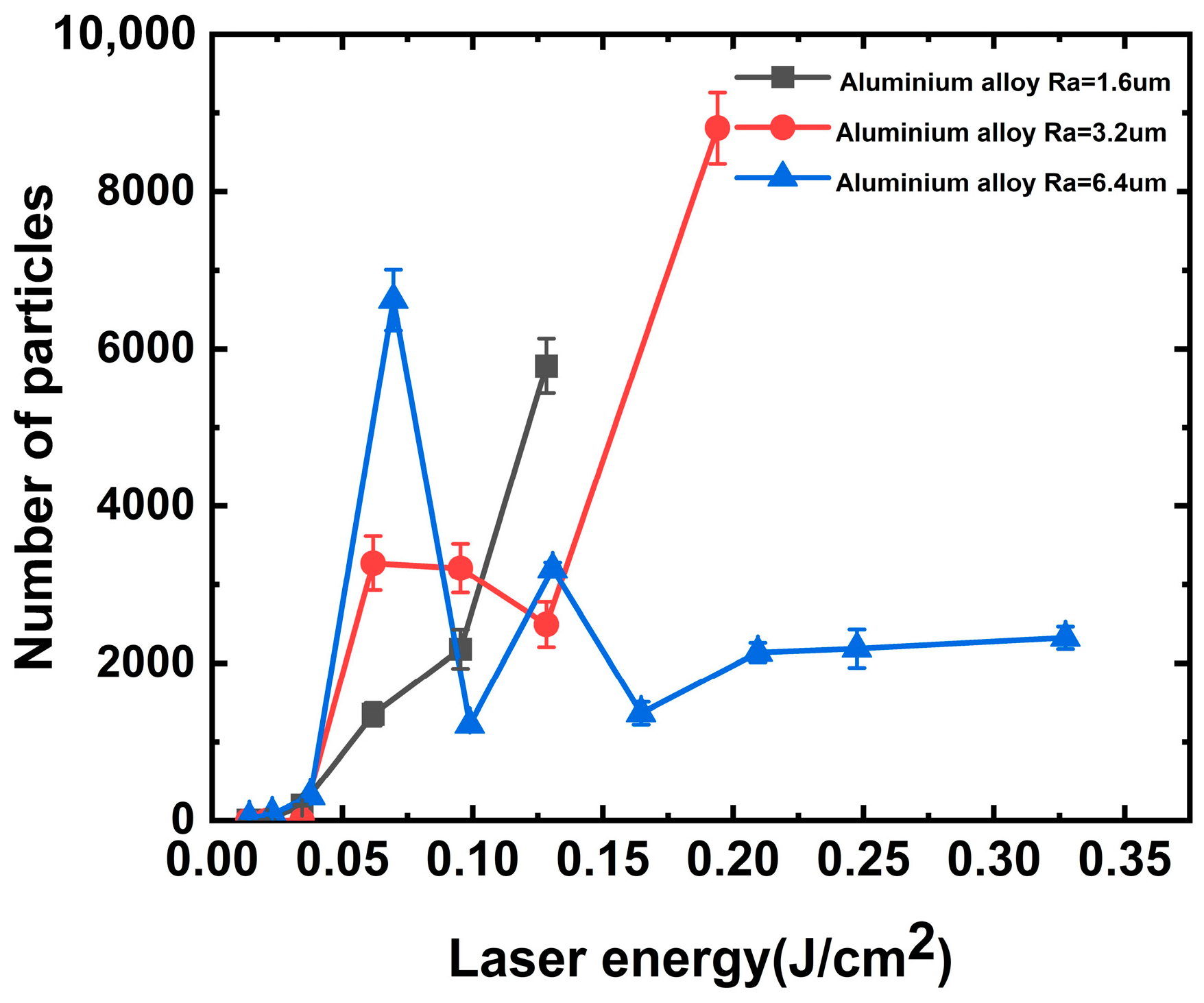
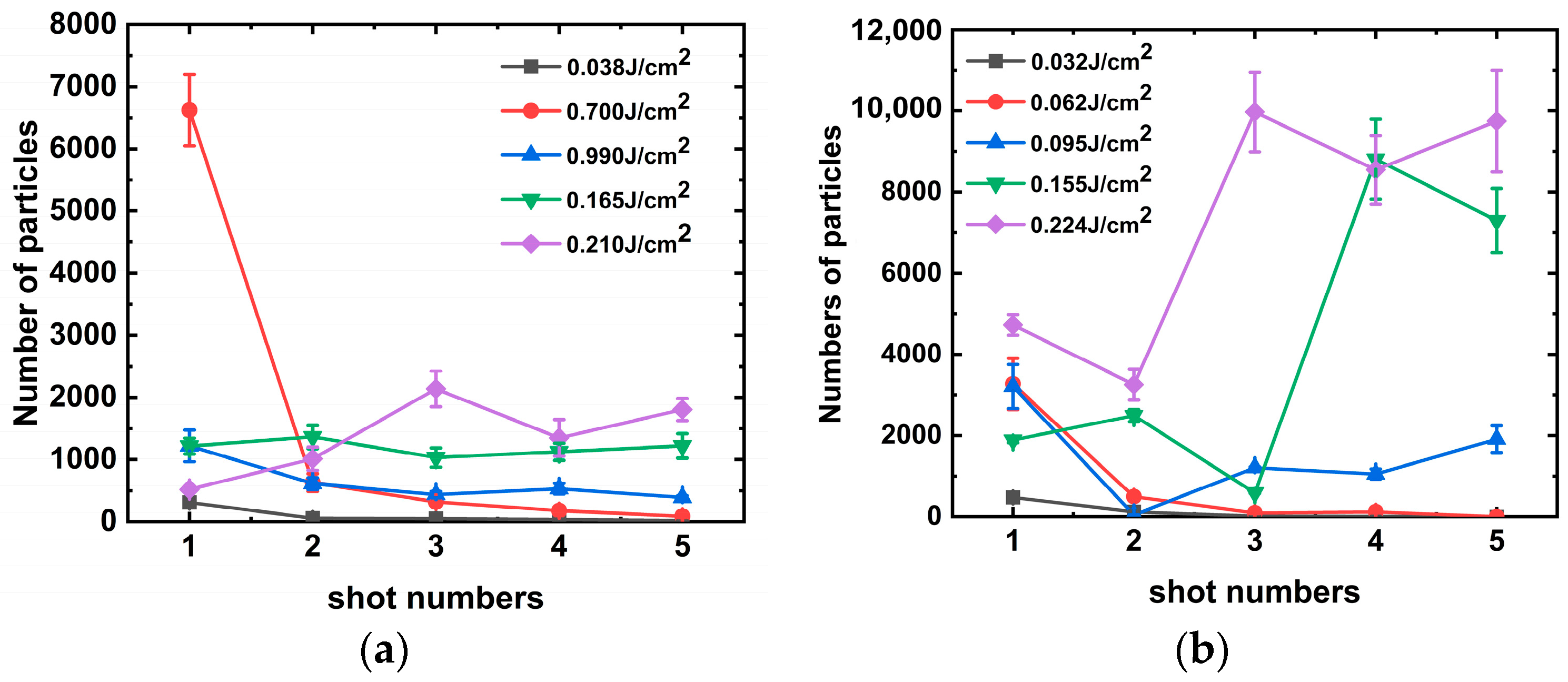
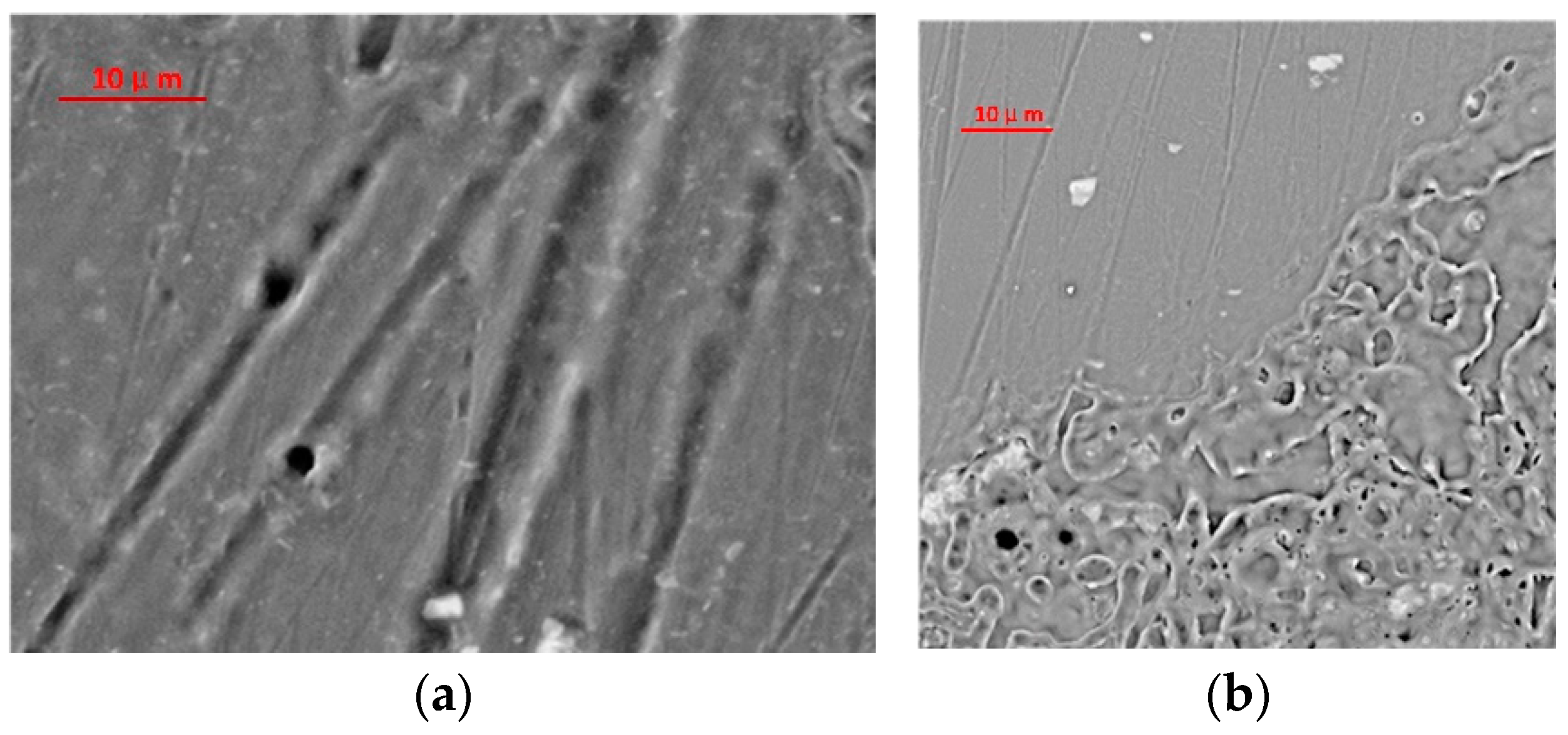
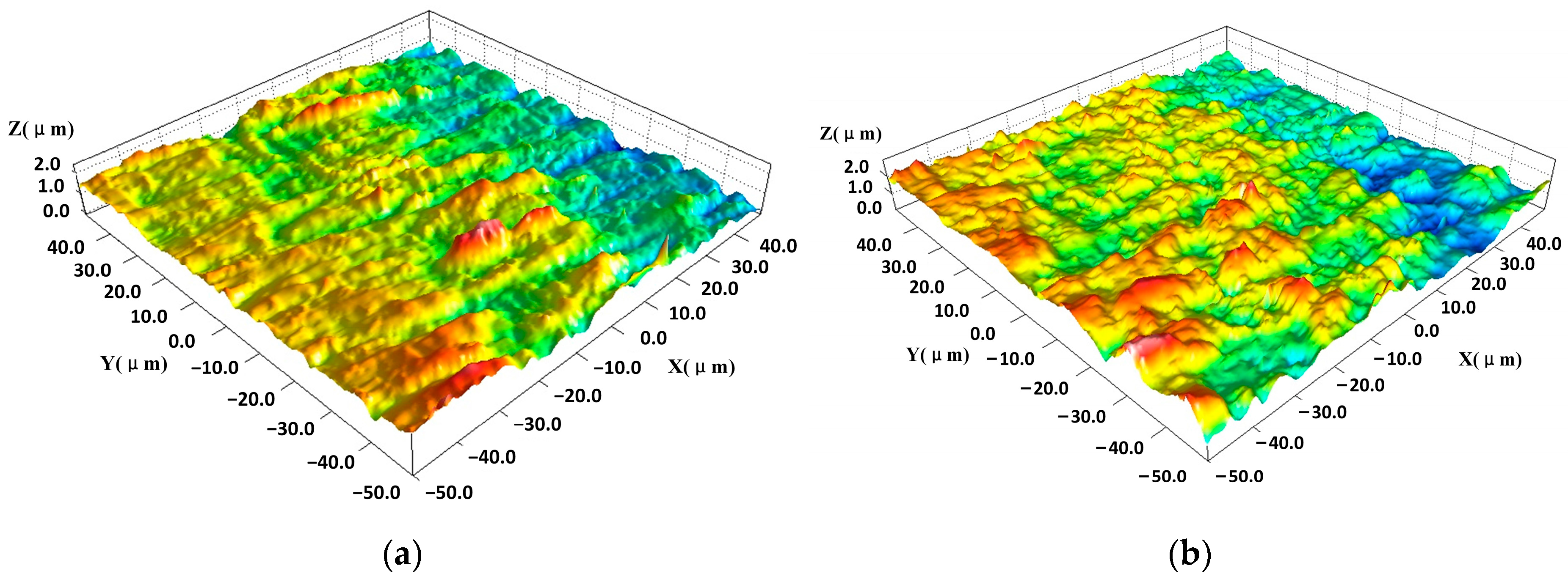


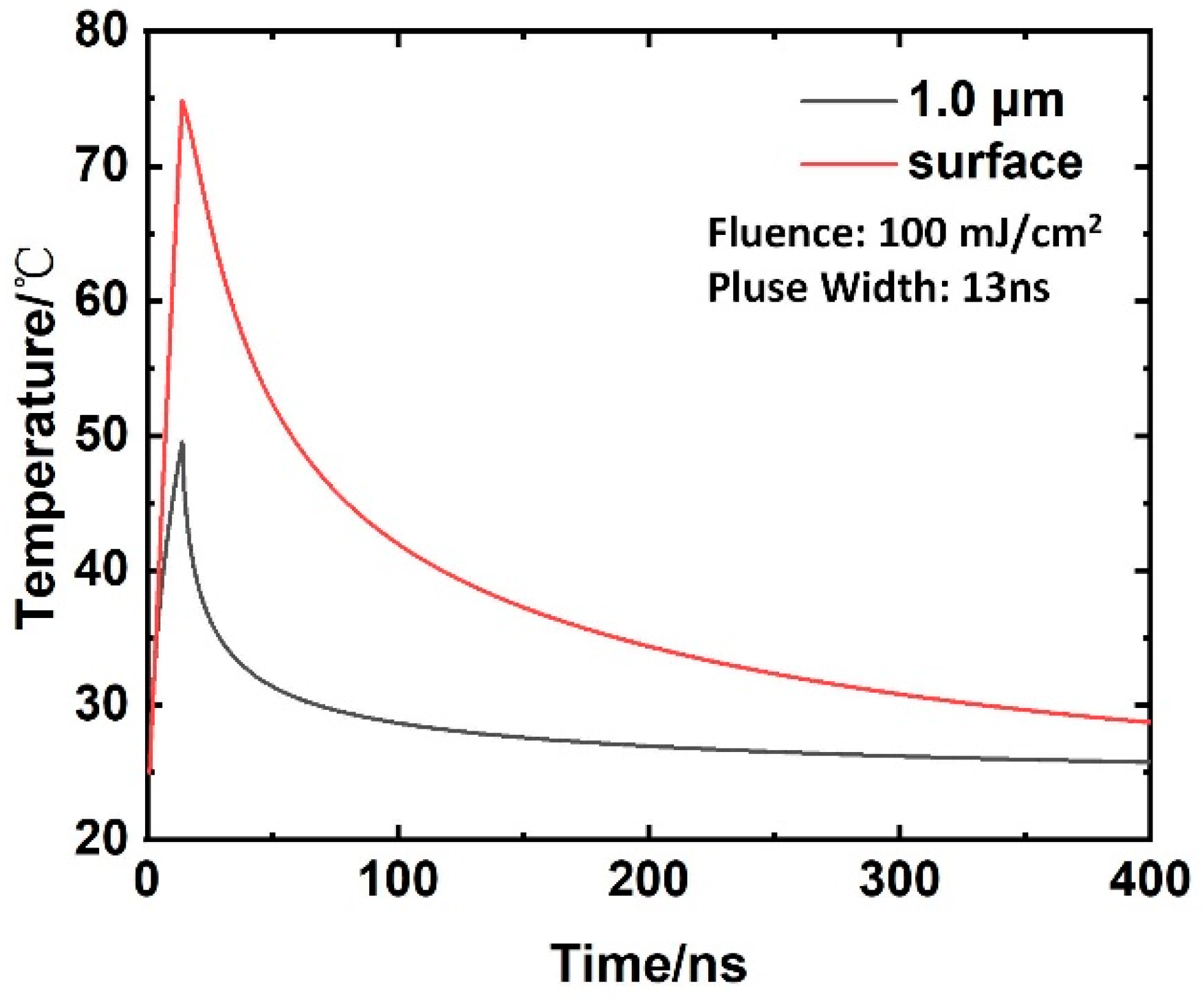
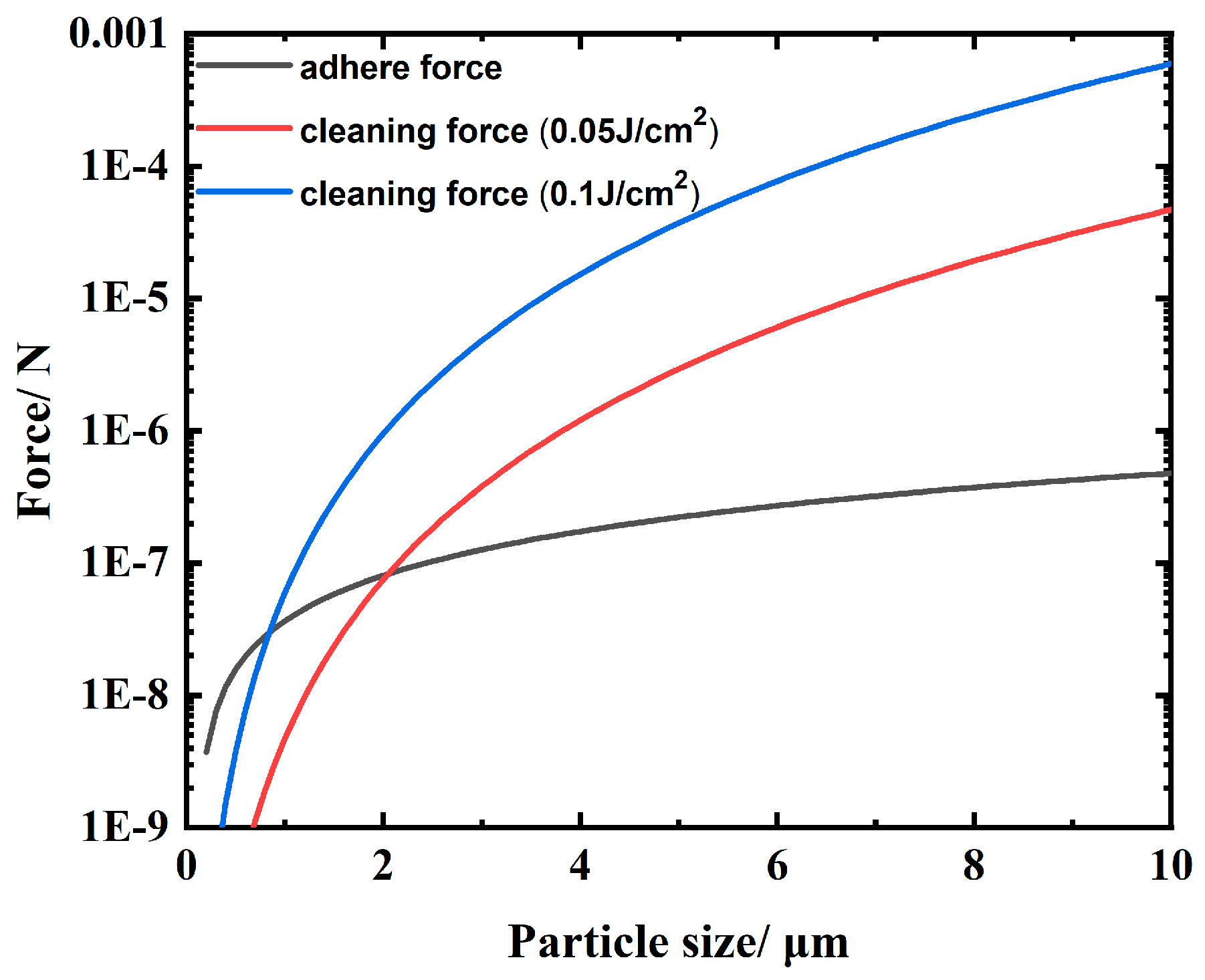
| Alloy | Al | Si | Cu | Mg | Zn | Mn | Ti | Cr | Fe |
|---|---|---|---|---|---|---|---|---|---|
| 5083 | Bal. | 0.40 | 0.10 | 4.0–4.9 | 0.25 | 0.4–1.0 | 0.15 | 0.05–0.25 | 0.4 |
| Parameter | Value |
|---|---|
| Density/(kg/m3) | 2770 |
| Specific heat/(J/kg·K) | 875 |
| Thermal conductivity/(W/m·K) | 190 |
| Poisson coefficient | 0.33 |
| Young’s modulus/Gpa | 70.3 |
| Hamke constant(Al-Al) | 33 × 10−20 |
| Thermal expansion coefficient/K | 23.21 × 10−6 |
| Roughness | Reflectance at 1064 nm | Reflectance at 351 nm |
|---|---|---|
| 1.6 μm | 23.64 | 12.85 |
| 3.2 μm | 26.97 | 16.64 |
Disclaimer/Publisher’s Note: The statements, opinions and data contained in all publications are solely those of the individual author(s) and contributor(s) and not of MDPI and/or the editor(s). MDPI and/or the editor(s) disclaim responsibility for any injury to people or property resulting from any ideas, methods, instructions or products referred to in the content. |
© 2023 by the authors. Licensee MDPI, Basel, Switzerland. This article is an open access article distributed under the terms and conditions of the Creative Commons Attribution (CC BY) license (https://creativecommons.org/licenses/by/4.0/).
Share and Cite
Miao, X.; Zhou, G.; Zhu, Q.; Jiang, X.; Jiang, Y.; Yao, C.; Jiang, Y.; Niu, L.; Xiang, S.; Chen, J. The Characterization of Laser-Induced Particles Generated from Aluminum Alloy in High Power Laser Facility. Materials 2023, 16, 7415. https://doi.org/10.3390/ma16237415
Miao X, Zhou G, Zhu Q, Jiang X, Jiang Y, Yao C, Jiang Y, Niu L, Xiang S, Chen J. The Characterization of Laser-Induced Particles Generated from Aluminum Alloy in High Power Laser Facility. Materials. 2023; 16(23):7415. https://doi.org/10.3390/ma16237415
Chicago/Turabian StyleMiao, Xinxiang, Guorui Zhou, Qihua Zhu, Xiaodong Jiang, Yong Jiang, Caizhen Yao, Yilan Jiang, Longfei Niu, Siheng Xiang, and Jiaxuan Chen. 2023. "The Characterization of Laser-Induced Particles Generated from Aluminum Alloy in High Power Laser Facility" Materials 16, no. 23: 7415. https://doi.org/10.3390/ma16237415
APA StyleMiao, X., Zhou, G., Zhu, Q., Jiang, X., Jiang, Y., Yao, C., Jiang, Y., Niu, L., Xiang, S., & Chen, J. (2023). The Characterization of Laser-Induced Particles Generated from Aluminum Alloy in High Power Laser Facility. Materials, 16(23), 7415. https://doi.org/10.3390/ma16237415






